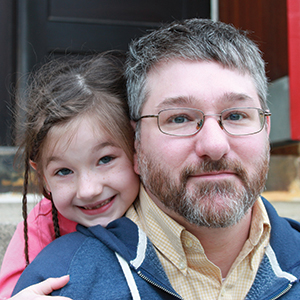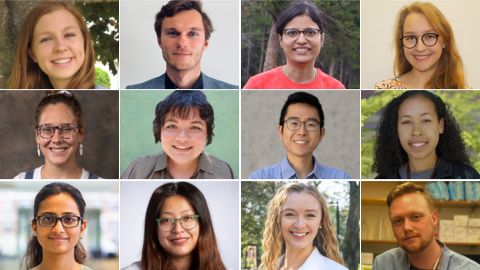Burning fat and balancing liver lipids
Michael Wolfgang of the Johns Hopkins University, a member of the American Society for Biochemistry and Molecular Biology, wants to figure out on a biochemical level how your body burns fat. One of the projects his laboratory members are working on is looking at the liver’s role in oxidizing fatty acids in mice. Wolfgang’s research also focuses on metabolic regulation and genetics in the liver and neurons as well as their effects on diabetes, obesity and brown-fat accumulation.
 Michael Wolfgang with his daughter Alexandria.
Michael Wolfgang with his daughter Alexandria.
However, Wolfgang, who joined the Hopkins faculty in 2008 after completing his postdoctoral training at Johns Hopkins University School of Medicine, didn’t always see himself as a metabolic researcher. A childhood surrounded by sheep, chickens and pigs on a small farm in Illinois initially sent him on a path to becoming a pig farmer. This led him to an undergraduate degree in animal sciences from the University of Illinois–Urbana Champaign followed by a Ph.D. in endocrinology and reproductive physiology from the University of Wisconsin–Madison.
John Arnst, ASBMB Today’s science writer, spoke with Wolfgang about his life and research and how a watershed moment witnessing in vitro fertilization led to a career ferreting out the interplay of metabolic regulation and genetics in both the liver and the brain. The interview has been edited for length and clarity.
What are some projects you’re working on?
In the brain, we’re trying to understand how several unique enzymes regulate lipid flux within the central nervous system and what impact that has on the behavior and the life and death of neurons and astrocytes. On the other end, a couple of the things we’re working on are how mitochondrial fatty acid oxidation affects hepatic — and really all kinds of cells — function in vivo. We have an ongoing project on adipose-tissue fatty-acid oxidation and hepatic fatty-acid oxidation and what roles they have.
What are you starting to find regarding fatty-acid oxidation?
Well, the liver is quite interesting. I never thought of myself as a liver biologist, although we study metabolism, because I thought we knew everything there was to know about fatty (-acid) oxidation in the liver. When we knock out hepatic fatty-acid oxidation in livers, we would have expected the mice not to survive, and we certainly would not have expected them to survive a 24-hour fast. They actually survive both of those things. The mouse makes adaptations to survive that actually become rather normal from a whole-body standpoint and are fascinating. We’re trying to understand how this happens and how the liver is communicating this dysfunction to the other tissues.
How long did the mice survive with hepatic fatty-acid oxidation knocked out?
They can survive forever.
Wow.
Right? So this is kind of a basic biochemical textbook thing. I was so surprised by this that I actually didn’t believe it for the longest time until I actually got in and did a couple of experiments with the graduate student myself. Fatty-acid oxidation is essential to gluconeogenesis, essential to ketone production. It’s the major fuel that the liver uses during fasting, and the amount of plasticity and organismal flexibility is just incredible to me.
What led you to exploring these two avenues?
When I was a postdoc, we were studying a very atypical enzyme that’s very neuron-specific, carnitine palmitoyltransferase (CPT) 1C. We know a lot about CPT 1A and CPT 1B and what those functions are in vivo as a rate-setting step in fatty acid oxidation. Neurons express this bizarre enzyme that’s encoded by another gene. It looks very similar to both of those enzymes but in a very unusual place. It’s fairly neuron-specific under normal circumstances. We knocked it out. Mice have an interesting phenotype, but trying to understand what those phenotypes were in that context was difficult, because I didn’t think we knew enough about how the brain utilizes lipids at a very basic level.
I also wanted to ask what the role of fatty-acid oxidation was in the nervous system. That’s sort of how all of these projects got started — by just re-examining, well, do we really understand how these basic processes work in a physiological context?
Who would you say are some of your mentors?
Probably the biggest mentor for me was Dan Lane. (Author’s note: M. Daniel Lane was a biochemist at Hopkins who studied biotin-dependent carboxylation, adipogenesis and insulin signaling. He passed away in 2014.) Just how he approached science, how he mentored students and postdocs, has probably been the biggest influence on me scientifically. He was one of the first adopters of the 3T3-L1 system for adipocyte differentiation, so he made a lot of progress in that. (Author’s note: The 3T3-L1 system is a cell line derived from mouse cells that is essential for research with adipose tissues.) When I joined his lab, he was interested in understanding how some of these processes work in the nervous system.
What do you think are some of the major issues or trends that might affect scientists’ livelihoods?
The reproducibility issues, I think, are kind of coming to the fore, and certainly this type of thinking is impacting how we think about moving forward. Of course, funding is always an issue — not just short-term funding but longer-term funding — because I’m not old. I’m just a young buck now. (Author’s note: Wolfgang is 40 years old.) So that’s a little bit daunting, thinking about how this will be carried on for the next 20 years.
Did you always know that you wanted to be a scientist?
Oh no, no, no — I didn’t go to school to become a scientist. I went to school to become a pig farmer.
How did that transition happen?
I took a course at the University of Illinois. I was an animal-sciences major, and there are two tracks in animal science. There’s a management track where you manage industrial hog farms, which is what I thought I was going to do, and then the other track is science-focused. I took a course in reproductive biology at U of I, and it was just so fascinating to me. They have a really interesting undergraduate program where there’s a lot of hands-on science. In one of the labs that we took, we were doing in vitro fertilization. To watch that process in front of me was just one of the most amazing things I’ve ever seen. It hooked me, and I wanted to learn more about science.
What was it that made you want to be a pig farmer?
We had a small farm, 35 acres. We had sheep and chickens and a couple of pigs. When I was 16, I got a job on a large family farm harvesting and planting horseradish. They also raised a lot of hogs. After the horseradish season was over, I started working in the farrowing houses and really loved it. So much so that I thought it would make an interesting career.
Is there any advice you’d give to graduate students?
Well, you have to do something that you love, because there are few rewards other than discovering something. That’s probably the best reward there is — when you have data that you’ve discovered. If that doesn’t get you up in the morning, there’s no reason to do this. You really have to be able to have the love of it to keep going.
We’ve talked about your life in the lab. How about your life outside of it?
I have three children. I basically do two things: I work and I spend time with my family. And that’s about it. A lot of our free time is devoted to them. There are a lot of things to do within two hours of Baltimore. We go to the beach, go to a park. We’re always doing something.
In regards to your work and your life, you have an overarching motto?
No. You know who David Sedaris is? He says life is like four burners. Do you know this? (Author’s note: In a 2009 article in The New Yorker, humorist David Sedaris mentioned a friend’s concept of life management as a stove with four burners: family, friends, health and work. The idea put forth is that, a person has to turn off one of the burners to manage a career successfully; to be truly successful professionally, a person must turn off two burners.)
I think he mentioned if you want to be successful, you have to turn off one, and if you want to be really successful, you have to turn off two.
Right, right. My wife keeps telling me I need to exercise, but I was like, “Well, David Sedaris said I can’t do that.”
Enjoy reading ASBMB Today?
Become a member to receive the print edition monthly and the digital edition weekly.
Learn moreGet the latest from ASBMB Today
Enter your email address, and we’ll send you a weekly email with recent articles, interviews and more.
Latest in People
People highlights or most popular articles

Charles O. Rock (1949 – 2023)
Colleagues and trainees remember a world expert in membrane lipid homeostasis.

Honors for Clemons, Hatzios and Wiemer
Awards, honors, milestones and more. Find out what's happening in the lives of ASBMB members.

Touching the future from the bench
Scholar, scientist, teacher and mentor Odutayo Odunuga discusses the important roles of the institutional PI, his journey and his research.

In memoriam: Darwin Prockop
He held leadership positions at multiple institutions and was known for his contributions to adult stem cell biology and cellular biology.

A look into medical writing
Our careers columnist spoke with Ashlea A. Morgan at Chameleon Communications International to get a sense of one type of work a medical writer can do.

ATP delegates push for improved policies
This ASBMB program helps advocates gain skills to address issues that affect science and scientists.

